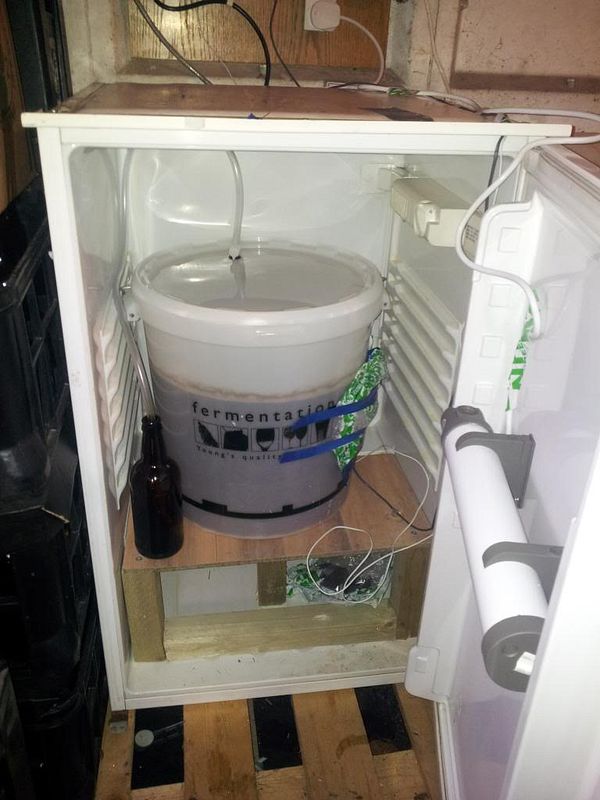I actually used an old body warmer the air lock sticking out of the neck, it did work, however one needed to be monitoring the temperature, this is the problem be it bottles of ice or cloth and fans although you can cool you need to monitor the temperature, I suppose the Inkbird could control when a fan runs, but with the refrigeration unit be is a freezer or fridge you set it up and forget for 7 days.
I first saw the use of wet material used to cool in Algeria in the 1980's, the wagon drivers had their water bottle covered and would hang it off their wing mirrors. But to use latent heat of evaporation means you are filling the room with very humid air, so the room needs ventilating, the drier the air the better it works, also the more surface area the better, but there comes a point where the material is insulating too much, so keeping beer warm.
This is also a problem with a fridge, it stops the heat leaving the fermenter, so without a fridge I could brew 9 months of the year with brew getting too hot, with a fridge the motor runs 9 months of the year as the heat can't escape without it running. However it only runs for first few days of starting a brew, once the first few days are over it does not run. My idea was to use the old fridge/freezer in the garage so moving brewing out of kitchen and not using the motor, however I was forced to use motor once in the fridge the box kept in the heat. Idea of leaving door open did not work, I would forget inside the garage. However after being in the freezer compartment for 6 days held at 19ðC I could then move it to fridge compartment which has no cooling for the remaining 14 days before I bottle. The garage temperature may go up and down from 12ðC to 30ðC between day and night, but inside the fridge the temperature remains steady with only heating at 22ðC.
I would not now want to brew without my fridge/freezer, but know it can be done if your willing to put in enough time and effort to control the temperature, the problem is without the fine temperature control you get with a brew fridge, any experiment with the beer, your not sure if result is due to experiment or due to temperature. Once I moved to the brew fridge method, I realised my stick on temperature strip is measuring an average between brew temperature and ambient temperature, once I started using a sensor held against the side of fermenter under a sponge to insulate it from ambient I noted in the brew fridge how to start with the sensor was showing hotter than the stick on strip, but as the fermenting draws to an end the two show the same temperature.
Before the brew fridge I had worked out 17ðC was the point where the yeast became dormant, at 18ðC it was working happily, but when I started to use brew fridge I found 18ðC was point where yeast became dormant, 19ðC was the temperature required for everything to work well, the difference was not the temperature, but method of measuring temperature, the stick on stick was measuring some where between air temperature and fermenter temperature.
This error in measuring the temperature means likely when I thought my brew was at 22ðC in the kitchen likely it was hotter than that, it also meant when it was showing 18ðC at end of brewing it was likely too cold, which explained why I had some very long times before the hydrometer dropped enough to bottle.
I am talking about my errors measuring temperature as if you cover the fermenter with wet cloth you will also be unable to use any temperature gauge which is being cooled directly by the cloth, I got a thermometer with a sensor for outside from Lidi, I could dangle that sensor into the brew, so I had a measurement centre of brew, and on the outside of fermenter under a sponge, it showed 0.7ðC difference as start of new brew centre being warmer. Once I knew this I stopped measuring at centre as it could contaminate the brew. I also used same device to measure air temperature in freezer and compare to brew temperature at start, with brew starting at 22ðC and set point 19ðC the sensor under the sponge held hard against the fermenter showed steady drop to 19ðC over an hours, it did not over shoot, the air temperature however went down to 8ðC then compressor switched off, it rose to 16ðC then compressor started again dropped to 10ðC compressor stopped second time and then the two temperatures slowly both started to read 18ðC air and 19ðC brew for next few days. I would say that 75W motor ran for around 45 minutes in all to reduce the temperature that 3ðC, that is a lot of energy to remove just 3ðC from the fermenter, with wet towels it would take all day to cool it that much, so what you need to do is not let it get hot to start with.
Using some 2 litre bottles which have been frozen in the freezer to cool the brew is in many ways easier, you have brew at 24ðC you want 19ðC so 5ðC to remove bottles still have a little water unfrozen so assume at zero so 80 x 2 litre latent heat of fusion plus 19 x 2 litre = around 100 x 2 litre so 22/2 = 11 so 100/11 = 10ðC one bottle will cool, since there is heat being also added by brewing and ambient, one bottle every 24 hours will likely cool it enough.







